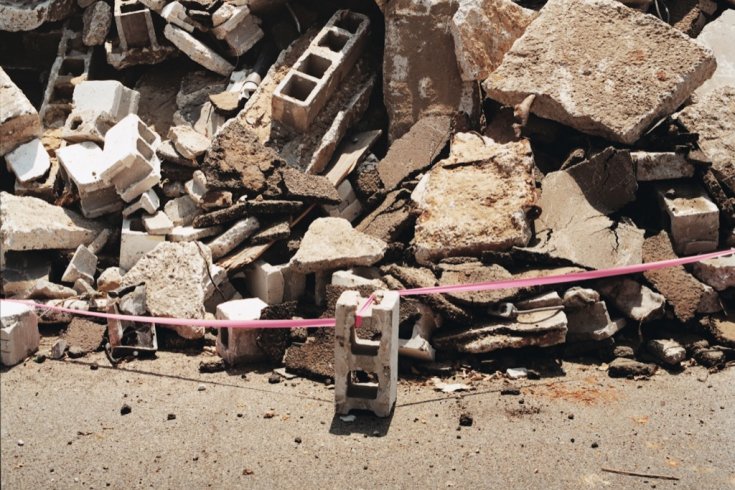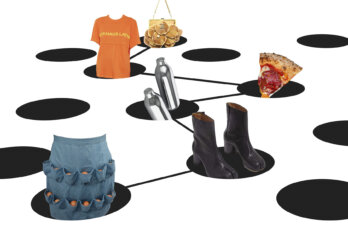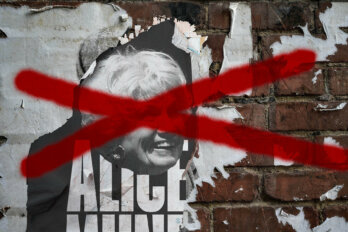The elevated freeways of New Orleans were empty except for a few garbage-strewn encampments of hurricane refugees huddled along the railings. Devoid of traffic, the open belts of asphalt looked wide and graceful. Below the highway the dark floodwaters reflected a bent and oily version of the buildings and brilliant blue posthurricane sky. The police department and local government had evaporated in the storm, and the military was only just arriving.
Driving the wrong way down the empty four-lane freeways I hit speeds of ninety miles per hour, my rental car’s trunk filled with extra water, gasoline, and canned sardines. At the base of a bridge in a dry section of town stands a McDonald’s sign stripped of its yellow and red plastic, reduced to a skeletal M. Nearby a city bus is jackknifed in the street. Moving east through Westwego and Gretna, I meet a rescue crew following the stench of corpses into some rubble.
I had entered not so much a physical place as a new era: the bad future, the long-predicted beginning of the end, the time ruled by cataclysmic climate change. Returning to New Orleans and the Gulf Coast six months after the levees broke, I found the situation even worse. Most of eastern New Orleans — low-lying, poor, and largely African-American — is battered, flooded, looted, and now rotting. Its sodden houses are being mucked out by salvage crews, the rancid mouldering insides — carpets, clothing, drywall, appliances, old family photos — are piled in mangled heaps on the streets and left to fester for months. The federal government’s reconstruction efforts have been half-hearted, incompetent, and riddled with graft. In all these respects, post-hurricane New Orleans may be an accurate harbinger of what global warming and climate change could mean: social breakdown, poverty, corruption, and disease.
There is no longer any real debate: the earth’s climate is warming and will change significantly within most of our lifetimes. Most heavily impacted will be coastal cities, the economic hubs of modern human civilization. They are the cockpits of commerce, trade, research, transportation, and education, the nodes that link the world economy together.
Many civilizations have lived in the shadow of their own end-time narratives and it would be nice to discount the story of climate change as the same old archetypal vision of the apocalypse played out in a secularized form. But this time the story is backed up by sophisticated science, most of which is converging into an unassailable consensus.
The books under review here share substantial overlap, to the point where they are almost variations on the same template. This reflects the fact that scientists with different specialties — the atmosphere, ocean currents, the ancient fossil record, ecosystems — are all independently arriving at similar conclusions. Their outline runs as follows: the basic problem of global warming; the ancient history of climate and the components of the climate system; the gathering crisis of extinction and loss of biodiversity; the mendacious industry driven politics of climate-change skepticism; and finally, discussions of what must be done.
Perhaps the most elegant is New Yorker writer Elizabeth Kolbert’s Field Notes from a Catastrophe. Literary in tone, Kolbert’s book is written in the form of a travelogue. She goes to where the science is being done and meets the people there — Inuit hunters, Princeton Ph.D.s, people who build floating houses in Holland.
The central facts described by Kolbert are deeply troubling. For the last 650,000 years atmospheric levels of carbon dioxide (CO2 ) — the main heat trapping gas in the earth’s environment — have hovered at around 250 parts per million. At no point in the pre-industrial era did CO2 concentrations go above 300 parts per million. By 1959 they had reached 316 parts per million. They are now at 378 and are expected to double by mid-century. No one knows what concentration of atmospheric CO2 will push us past the point of no return, the threshold after which we are caught in runaway global warming. Is it 500 parts per million? Is it 600 parts per million, or even 700? No credible scientist thinks it is much higher than that.
In The Weather Makers, Tim Flannery identifies our new climate era using Nobel laureate Paul Crutzen’s concept of the “Anthropocene” — the man-made climate begun 200 years ago with the Industrial Revolution’s use of coal power. Before that came the Holocene, “the 8,000 year long summer,” a period of relative calm, warmth, and stability during which human civilization arose. Flannery describes the Holocene as “without a doubt the crucial event in human history.” One suspects that the Anthropocene might be the next and last crucial event.
Eugene Linden’s superb The Winds of Change is also crystal clear on the science and the natural and social history of climate change. Like Jared Diamond in Collapse, Linden draws on the story of the Norse colonies in Greenland, which prospered for 500 years and then died out. The Greenland Norse survived as an economic outpost of feudal Europe, exporting ivory and hides back to the old world and importing priests, wine, and cloth. Then around 1345, a 500-year-long cooling period settled upon the globe. Average global temperature dropped by 0.5 to 1°C, and the North Atlantic’s fell by as much as 3°. For the isolated Greenland Norse, the climate shift meant they were suddenly cut off from Denmark. Their society proved incapable of adapting. The settlement on the western shore collapsed in 1355; the eastern settlement hung on for roughly another 100 years.
Linden points out that cold weather alone did not kill the Greenlanders; their own political limitations, including racism and a rigid class hierarchy, also contributed. Based on the historical and archaeological record, he suggests that “the Christian Norse likely regarded the shamanistic Inuit as unenlightened and beneath them.” The Inuit, who arrived 100 years after the Norse, were known by the Viking settlers as Skraeling or “wretched people.” Instead of turning to the Inuit for help, the Norse simply perished. The lesson of this history is clear enough: adapt or die.
Following this logic throughout his book, Linden goes on to discuss the political impact of nineteenth-century El Niño events. This climatic phenomenon involves a weakening or reversal of the trade winds, building up warm surface water off the coast of South America and in turn destroying much needed fisheries and causing massive storms. To some extent Linden relies on Mike Davis’s pioneering book Late Victorian Holocausts to remind us that upheavals in the climate system often reinforce economic inequality and create social instability. “El Niño did not create the Third World, but it provided a powerful instrument to smash the traditional economies and social structures that formerly promised self-sufficiency in many parts of the tropics.” Linden’s message: the use of calamity to reinforce wealth and privilege is exactly what we do not need if we are to overcome the crisis of climate change.
In the last fifteen years the science of climate change has made radical advances, much of it thanks to sample cores from Greenland’s thick ice sheet and analyzing the content of tiny air bubbles in it. The Greenland Ice Sheet Project extracted an ice core over 3,000 metres deep, providing an accurate year-by-year climate record stretching back 110,000 years. Other data drawn from soil sediments and deeper ancient ice have pushed the record back 650,000 years.
Most disturbingly, ice-reading scientists now believe that past climate change was not always a linear process. Instead, the last 110,000 years have seen numerous rapid shifts in the global environment. Full-scale ice ages have started and stopped in mere decades rather than centuries. Other data shows that at times the seas rose and fell by several feet per decade. To paraphrase Linden, when considering the global thermostat we ought to think in terms not of a dial, but of an on-off switch.
Meticulously documented by Kolbert, Linden, and former US vice-president Al Gore, the key lesson concerns the crucial role of polar ice. The polar ice sheets currently throw back as much as 30 percent of the solar radiation hitting the earth, and the loss of this capacity will lead to an increased absorption of heat and an acceleration in warming — a positive-feedback loop whose effects compound and amplify the original cause. And the polar ice caps are now melting very quickly. Kolbert reports that, “since 1979 the perennial sea ice has shrunk by 250 million acres, an area the size of New York, Georgia, and Texas combined.”
An ice-free planet would bring with it sea levels sixty metres higher than today and the inundation of our coastal cities. But before the last stop of an ice-free Götterdämmerung lie other dangers. Sea ice, though formed in large part from salt water, has the salt pressed out of it over time so that icebergs are in effect desalinated by years of cold. Melting polar ice unleashes huge amounts of fresh water into the ocean and threatens to disrupt the global system of currents known as the “thermohaline circulation,” a flow system that redistributes heat and precipitation in ways that civilization depends on.
The North Atlantic offers the best example of this dynamic. Here the Gulf Stream sweeps north from the equator toward Europe carrying with it massive amounts of warm surface water. As the warm water approaches Europe it evaporates, dumping precipitation and heat on northern Europe. If half of the Greenland Ice Sheet melts along with half of the Antarctic Ice Sheet, it would disrupt the thermohaline circulation, probably plunging Europe into a very cold period just as the globe in general grew hotter. Among the potential consequences would be the undermining of European agriculture, an ensuing famine, and the mass migration of people to warmer climes.
The oceans are a hard-to-predict and dangerously slow indicator of climate change. The seas absorb huge amounts of CO2 and heat — exactly how much and to what effect are not clear. “It takes the oceans around three decades to catch up with the heat accumulated in the atmosphere,” writes Flannery. Some scientists fear that the oceans are so slow to catch up with atmospheric warming that we may have already gone over the edge and tripped the switch that will create an ice-free planet.
But never mind the bad future — climate change is already having measurable effects. Species are migrating toward the poles and to higher, cooler altitudes if they can. Caterpillars and migratory birds in Europe are increasingly out of sync, leaving their freshly hatched chicks with inadequate food. Multiply this dynamic 10,000 times and you get the picture: half of all species are “committed to extinction,” according to Flannery. And no one really understands the long-term effects of the incremental disruption of ecosystems on, for instance, the quality of soil, which is under increasing pressure to feed escalating urban populations.
In some ways the most important of these books is the simplest, Al Gore’s An Inconvenient Truth, a coffee-table slab of harrowing photos and graphs with straightforward text in the form of weighty captions. Based on Gore’s slideshow- cum-documentary, An Inconvenient Truth is highly effective in part because of the power of the graphics.
Gore’s high-profile persona — which is woven into the book, with chapters on his scientific mentor, Roger Revelle, his sister Nancy Gore Hunger, who died of cancer, and the impact of his son Albert’s struggle to recover from a childhood car accident — raises one of the most important questions of all: where are the elites in all of this?
The elites are not, it turns out, moving to save the natural systems that have so lavishly benefited them. During Gore’s vice-presidency, the US government had a problematic environmental record. nafta served to erode the possibility of stronger regulations, and as for the Kyoto Protocol on Climate Change, the international treaty designed to control carbon emissions, Clinton and Gore signed the treaty but did not submit it for ratification because it was clear that Congress would reject any treaty that did not restrict developing nations like India and China.
Some elites are mobilized on the climate issue, however: the captains of the energy industry, according to Gore, are doing everything they can to push policy in the wrong direction. The multinational companies with the most at stake have spent vast sums to deceive and confuse the public by promoting a handful of climate skeptics, says Gore. These are marginal scientists, backed by massive public-relations muscle, who raise doubts about the real scientific consensus and demand “balanced” news coverage — and usually get it. While scientific opinion as expressed in peer-reviewed journals is unanimous that global warming is both real and caused by human activity, coverage in the popular press has been evenly split, giving as much weight to a handful of skeptics as it does to hard science.
The opening salvo of George Monbiot’s Heat: How to Stop the Planet from Burning is a devastating exposé of the climate skeptics, who, he insists, are almost entirely dependent on funding from Exxon-Mobil. Or not quite his opening salvo. In the foreword to the Canadian edition of his book, Monbiot delivers a fierce invective debunking Canada’s undeserved reputation for being environmentally friendly. According to Monbiot, Canada’s greenhouse- gas emissions are on par with those of the worst per-capita offenders, the US and Australia. Canadians emit on average 19.05 tonnes of CO2 per year, compared with 9.5 tonnes in Britain, 6.8 in France, and 10.2 in Germany. “Nice and well-intentioned as you are,” Monbiot inveighs, “you do as much to drown Bangladesh or starve the people of the Horn of Africa as the most obdurate throw-backs of the shrinking state of Bushistan.”
For Monbiot, the upper limit of atmospheric carbon stabilization is at 400 to 450 parts per billion, at which level the mean atmospheric temperature would be 2ºC higher. Such a change would bring about calamitous environmental transformation: many more cities devastated by hurricanes, brutal droughts, epidemics, and all the attendant riots and insurrections. Any further heating would likely mean runaway global warming and profound social breakdown as the major cities of the world are overwhelmed by flooding and political chaos. To stabilize emissions at the edge of the cliff, Monbiot argues, heavy polluters like Canada, Australia, Britain, and the US need to reduce emissions by as much as 90 percent by 2030.
The scientific and political challenges presented by global climate change make the more easily solved issues that defined the environmental movement thirty years ago — acid rain, smog, pollution of drinking water by pesticides, and toxic waste — seem minor-league. Any solution will most likely involve fundamentally changing the way we live. The task of transformation is daunting but not impossible.
Monbiot examines electricity generation, transport, home energy use, and cement manufacturing. Among the most promising technologies for green energy is offshore wind power. Hydro power has problems but is capable of generating plenty of electricity. Solar power, when you really do the math, is not as robust a large-scale technology as was at first hoped. Nuclear power does not cut it on purely economic grounds: it is simply too capital intensive and takes too long to come online to actually have an important impact on fighting global warming.
Along with green power there is the possibility of zero-emission fossil fuels through carbon capture and sequestration. Turned into a liquid, CO2 can be pumped into underground geological formations for long-term storage. Already several oil companies, most notably Norway’s Statoil, are injecting liquefied CO2 into oil wells to pressurize oil to the surface. Technology used in Uzbekistan and a few other countries allows for underground coal gasification, which turns coal into something akin to clean-burning natural gas, leaving most of the carbon below ground. But these technologies are very expensive, and industry rarely chooses more expensive methods unless forced to by government regulation.
Whatever combinations of real remedies are attempted, the effort to replace 150 years of infrastructural investment in a carbon-based economy will take a Herculean effort. Gore asserts that we already have all the technology we need to tackle this problem. However, as one of Kolbert’s sources soberly explains, this is only “true in the sense that in 1939, the technical and scientific expertise to build nuclear weapons existed . . . it took the Manhattan Project to make it so.”
As I cross the high Crescent City Connection Bridge and descend toward the heart of New Orleans, the Superdome appears like a sinister disabled spacecraft, its plastic roof hanging in strips down one side. There, surrounded by water, I stop and look out. Below, a survivor wades through the brackish water, then another floats past on a homemade raft. A few columns of smoke drift up from the horizon. Later, I see horses and mules wandering the city, packs of abandoned dogs on their way to becoming feral, and a corpse sitting for days unattended in the sun. If we wait much longer before beginning the full-scale transition to a carbon-free economy, this may end up being an ordinary scene in many of our coastal cities. The sea will begin to inundate those places we need most if we are to build a post-carbon economy: the great coastal cities with their universities, laboratories, industries, and ports. If we wait much longer we will all be from New Orleans.





